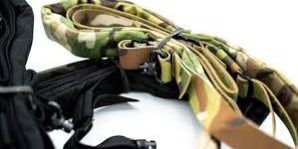Rifle Slings: Everything You Need to Know About Setup and Adjustment
So you are buying a shiny new rifle from Mitchell Defense, but want to ensure the most comfortable shooting experience. Rifle Slings are the next purchase you should make. Rifle slings are essential accessories for any shooter, offering not only ease of carry but also stability and improved accuracy when firing. Understanding how to properly set up and adjust your rifle sling can go a long way in enhancing your shooting experience, whether you’re hunting, in competition, or simply practicing at the range.
Choosing the Right Sling and Setup
The first step in utilizing a rifle sling effectively is choosing the right type for your needs. Slings range from simple two-point designs to more complex three-point configurations. For precision shooting, such as with a match rifle or a biathlon rifle, a sling that offers stable support in the standing position is crucial. Materials can vary from durable nylon to high-end leather, each offering different levels of comfort and durability.
Installation and Adjustment
To install a sling, you’ll typically need a sling swivel—a small device that allows the sling to be securely attached to the rifle. Most modern rifles come equipped with sling swivel studs where the sling can be easily hooked. An allen wrench may be required to tighten these swivels to ensure they are secure.
Adjusting the sling correctly is critical for proper rifle handling. The length of the sling should allow you to carry the rifle comfortably across your body or back, without excessive slack. For shooting, the sling should be tight enough to provide support but not so tight that it causes discomfort or restricts movement.
Specialized Setups
For those involved in activities like saddle hunting, where mobility and stability are crucial, setting up your sling to allow for quick adjustments can be beneficial. This might involve configuring the sling to work seamlessly with a lineman belt or tree saddle, ensuring that the rifle can be accessed swiftly and safely.
Using Slings with Other Equipment
Integrating a sling with other shooting accessories can enhance its functionality. For instance, if you’re using a red dot sight or iron sights, you’ll want to ensure that the sling does not obstruct your view or interfere with the front sight or rear sight. Similarly, for those who use an appendix holster (AIWB holster) or any other type of holster, ensuring that the sling does not catch on the holster when drawing a sidearm is essential.
Personalization and Comfort
Adjusting a sling isn’t just about functionality; comfort is also key, especially during long periods of use. Many shooters find that adding a silicone sheet or comfort channel to the sling where it contacts the shoulder can significantly enhance comfort. The adjustment should consider your body type and waist size to ensure the sling does not impede movement or constrict blood flow due to excessive tightness.
Maintenance and Care
Maintaining your sling is as important as any other part of your rifle setup. Regular checks for wear and tear, especially on the hooked ends and adjustment mechanisms, will ensure longevity and reliability. Cleaning the sling according to the manufacturer’s instructions, especially if it’s made of materials like leather, will keep it in good condition and prevent degradation over time.
MD’s Personal Favorite
When it comes to choosing slings here at Mitchell, our standard go-to is Ryker USA. These slings are known for their innovative design and functionality. Ryker offers shooters a unique and effective solution for rifle handling and stability. Ryker applied the input of military and law enforcement professionals to engineera sling that enhances the shooter’s comfort, accuracy, and readiness.
Are they comfortable?
The ergonomic design of Ryker Slings is meant to distribute the weight of the firearm evenly across the body. This design reduces fatigue and strain on the shooter’s shoulder, allowing for longer periods of use without discomfort. The ergonomic benefits are particularly noticeable in dynamic shooting environments where mobility and endurance are crucial.
But what about integration with other gear?
Ryker slings are designed to integrate seamlessly with a wide range of tactical gear. The compatibility with different firearm models and accessory setups ensures that the sling enhances, rather than hinders, the shooter’s capability. This integration is crucial for law enforcement and military personnel who require a cohesive and functional gear setup to effectively perform their duties.
A well-chosen, properly adjusted rifle sling is more than just a carrying strap—it’s a tool that enhances the shooter’s accuracy, stability, and comfort. By understanding the basics of sling setup and adjustment, shooters can ensure they get the most out of this essential piece of shooting equipment, making every first shot count and improving overall performance in any shooting discipline.

